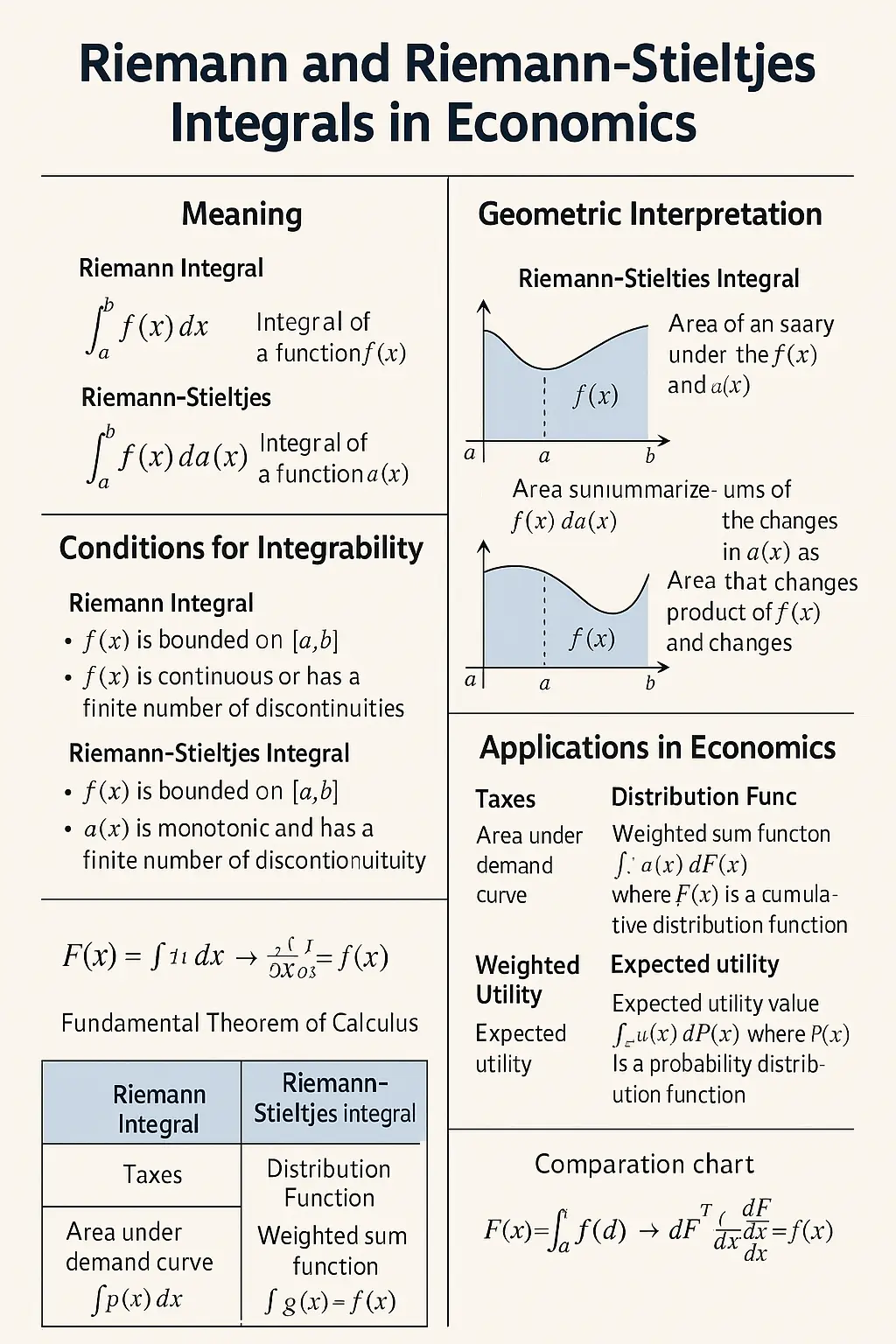Introduction
Integration plays a vital role in economics, especially when modeling accumulated values like total cost, revenue, or surplus. Two foundational concepts in integration theory are the Riemann integral and the more general Riemann-Stieltjes integral. While both are used to evaluate areas under curves, the Stieltjes approach allows for integration with respect to a function other than — an important distinction when modeling weights, distributions, or discontinuous data.
This blog post explores both integrals, their geometric interpretations, conditions for integrability, and relevance to economics.
1. The Riemann Integral: Basics and Intuition
The Riemann integral approximates the area under a curve over an interval by dividing it into rectangles.
Definition:
A function is Riemann integrable over if the limit of its upper and lower sums (based on partitioning the interval) exists and is equal:
Where:
- is a sample point in the -th subinterval
Geometric Interpretation:
The Riemann integral gives the net area under the curve, accounting for sign (area below the x-axis is negative).
2. Conditions for Riemann Integrability
A function is Riemann integrable on if:
- It is bounded
- The set of its discontinuities has measure zero (e.g., jump discontinuities at finite points are allowed)
Examples of integrable functions:
- Continuous functions
- Piecewise continuous functions
Non-integrable:
- Dirichlet function: too many discontinuities
3. The Riemann-Stieltjes Integral: Generalizing the Concept
The Riemann-Stieltjes integral extends the Riemann integral by replacing with :
Here, is a monotonic (non-decreasing) function, often interpreted as a weight, distribution, or cumulative change.
Geometric Meaning:
Rather than computing area under , we compute a weighted sum of based on how changes. When has jumps, the integral captures those discontinuous effects — useful for modeling taxes, benefits, or sudden pricing shifts.
4. Conditions for Riemann-Stieltjes Integrability
A function is Riemann-Stieltjes integrable with respect to if:
- is bounded on
- is monotonic
- is continuous at all points where is not constant
This makes the Riemann-Stieltjes integral more flexible than the Riemann integral.
5. Applications in Economics
- Probability-weighted expectations:
- where is a distribution function (expected value)
- Piecewise taxation/benefits:
- represents stepped tax brackets or subsidy jumps
- Utility with preferences:
- encodes behavioral biases or consumption weights
These scenarios require a framework that supports discontinuous or non-uniform accumulations — precisely what Riemann-Stieltjes provides.
6. Comparison Table
| Feature | Riemann Integral | Riemann-Stieltjes Integral |
|---|---|---|
| Integrates with respect to | (uniform change) | (custom weights) |
| Geometry | Area under | Weighted accumulation |
| Function types allowed | Continuous, bounded, piecewise | Monotonic weight function |
| Economics use cases | Cost, revenue, surplus | Weighted utility, taxes, distributions |
Conclusion
Understanding the Riemann and Riemann-Stieltjes integrals deepens our ability to model real-world economic systems. The Riemann integral captures continuous accumulation; the Riemann-Stieltjes integral accommodates discontinuities and non-uniform weights — making it ideal for modern, data-driven economic modeling.
Whether you’re studying marginal-to-total transitions or cumulative effects under complex rules, these integrals provide the mathematical foundation for nuanced, accurate results.
Further Reading
- Bartle & Sherbert, Introduction to Real Analysis
- Chiang & Wainwright, Fundamental Methods of Mathematical Economics

